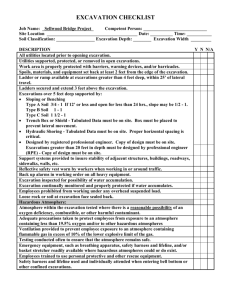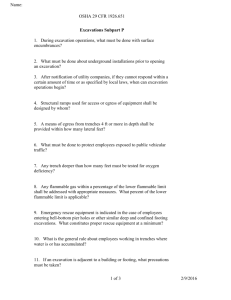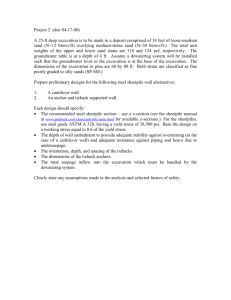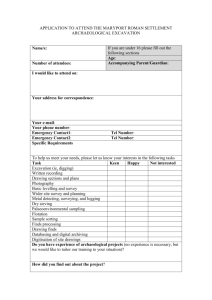Safe Operating Procedure (Revised 7/09) EXCAVATIONS
advertisement
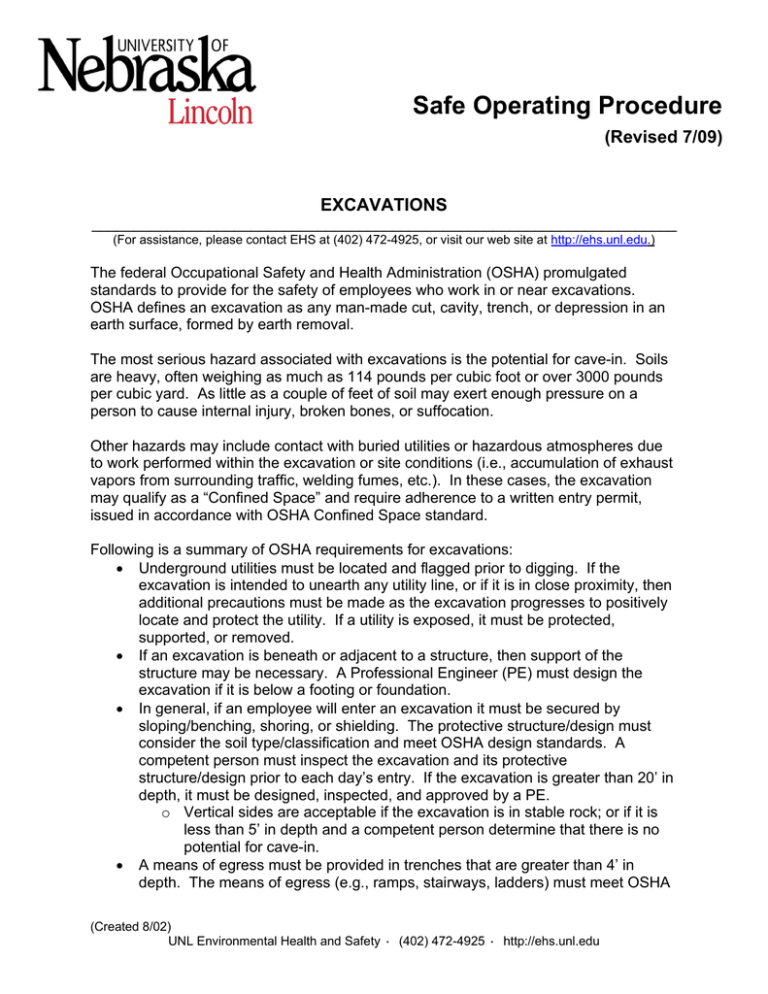
Safe Operating Procedure (Revised 7/09) EXCAVATIONS ______________________________________________________________________ (For assistance, please contact EHS at (402) 472-4925, or visit our web site at http://ehs.unl.edu.) The federal Occupational Safety and Health Administration (OSHA) promulgated standards to provide for the safety of employees who work in or near excavations. OSHA defines an excavation as any man-made cut, cavity, trench, or depression in an earth surface, formed by earth removal. The most serious hazard associated with excavations is the potential for cave-in. Soils are heavy, often weighing as much as 114 pounds per cubic foot or over 3000 pounds per cubic yard. As little as a couple of feet of soil may exert enough pressure on a person to cause internal injury, broken bones, or suffocation. Other hazards may include contact with buried utilities or hazardous atmospheres due to work performed within the excavation or site conditions (i.e., accumulation of exhaust vapors from surrounding traffic, welding fumes, etc.). In these cases, the excavation may qualify as a “Confined Space” and require adherence to a written entry permit, issued in accordance with OSHA Confined Space standard. Following is a summary of OSHA requirements for excavations: • Underground utilities must be located and flagged prior to digging. If the excavation is intended to unearth any utility line, or if it is in close proximity, then additional precautions must be made as the excavation progresses to positively locate and protect the utility. If a utility is exposed, it must be protected, supported, or removed. • If an excavation is beneath or adjacent to a structure, then support of the structure may be necessary. A Professional Engineer (PE) must design the excavation if it is below a footing or foundation. • In general, if an employee will enter an excavation it must be secured by sloping/benching, shoring, or shielding. The protective structure/design must consider the soil type/classification and meet OSHA design standards. A competent person must inspect the excavation and its protective structure/design prior to each day’s entry. If the excavation is greater than 20’ in depth, it must be designed, inspected, and approved by a PE. o Vertical sides are acceptable if the excavation is in stable rock; or if it is less than 5’ in depth and a competent person determine that there is no potential for cave-in. • A means of egress must be provided in trenches that are greater than 4’ in depth. The means of egress (e.g., ramps, stairways, ladders) must meet OSHA (Created 8/02) UNL Environmental Health and Safety · (402) 472-4925 · http://ehs.unl.edu • • • • design standards. In addition, more than one egress structure may be required depending on the size of the excavation. Excavations must be designed to protect against intrusion of storm water run-off. Workers must not enter an excavation with accumulated water. Excavations must be inspected by a competent person after a rainfall event. Persons who work in a trench must be protected from falling materials. Tools and other items/materials must be positioned at least 2’ from the edge of the excavation or secured from falling by a suitable restraining device. If an operator of equipment cannot clearly see the edge of an excavation they must be protected with barricades, signs (hand or mechanical), or other warning system to alert them when they are nearing the edge. Employees entering bell-bottom pier holes, or other similar deep and confined footing excavations, must wear a harness with a lifeline securely attached to it. The lifeline must be separate from any line used to handle materials, and individually attended at all times while the employee wearing the lifeline is in the excavation. (Created 8/02) UNL Environmental Health and Safety · (402) 472-4925 · http://ehs.unl.edu


